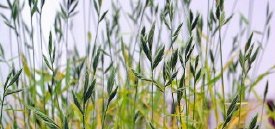Feb 15 2010
Biologist Samuel Hazen at the University of Massachusetts Amherst is one of more than 100 researchers who collaborated to publish this week in Nature, the entire genome of the model grass commonly known as purple false brome. It is the first member of this economically important grass family to have its DNA fully sequenced.

Hazen’s laboratory is one of 10 funded by the U.S. Department of Energy and U.S. Department of Agriculture in 2008 to accelerate the development of cellulosic biofuels such as the grass Brachypodium distachyon, widely regarded as one of the most promising alternatives on the horizon to reduce the country’s reliance on imported oil and to cut greenhouse gas emissions. UMass Amherst received $1.2 million of the total $10 million awarded two years ago.
The biologist says there are now 12 investigators in several laboratories on the UMass Amherst campus who make up the Brachypodium Consortium. They include microbiologists, plant scientists, chemists and molecular biologists who are “thrashing out the problems” and coming up with new ideas for using this previously overlooked non-food energy crop.
In several ways, Hazen points out, this grass is the opposite of what we desire in a crop — that is, a high-yielding plant. Unlike closely related food crops such as wheat, barley and nonfood energy crops such as switchgrass, B. distachyon is very small and has a short life cycle. But it is easily grown in the laboratory, making it an excellent model for genetic and molecular biology research. For example, biologists can grow a new generation of this grass in three months in the laboratory, compared to up to a full year for other grasses.
Specifically, Hazen and colleagues supplied gene transcript information and annotated the genes as part of the multi-center mapping study. The genome can be characterized as “a very large book that’s been printed without any spaces between the words,” he explains. To fix this monumental comprehension problem, he and colleagues pieced together the genetic words and phrases of the genome one at a time into meaningful “sentences.” Without this organizational step, the genome would not be useful to biological researchers.